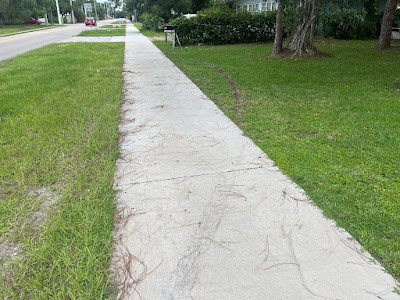The other day I took a ride to the ocean.
And I took another yesterday.
From those images, you probably can tell that I'm not talking about the Rockaways, Point Lookout or Coney Island, my most common sea-bound treks.
For that matter, I don't mean the Jersey Shore, where I haven't gone in some time. Rather, for the past two days, I've done two other seaside rides I've mentioned--though, again, not for some time--on this blog.
I arrived in Florida on Friday evening. The purpose of this trip is a visit with my father, whom I hadn't seen in three years, since my mother's funeral. We'd planned another visit but, like so many other plans by so many other people, it was put on hold when "COVID happened."
Since arriving, I've had nearly perfect weather for cycling and, of course, have taken advantage of it. The bike I rode during previous visits--a balloon-tired beach cruiser--got rusty and dusty. My father, thinking the bike was beyond redemption (it just looks that way) went and bought another bike--a cheapo full-suspension bike--from a friend. I rode it on Saturday, along the Lehigh Trail, over the bridge in the first photo and up Route A1A through Beverly Beach and Painters Hill.
Along the stretch from Flagler Beach to Beverly Beach, I was looking at some of what Hurricane Ian wrought. While the damage wasn't nearly as widespread as what befell Sanibel Island or Fort Myers, there were piles of debris on roadsides, testaments to damaged or destroyed buildings and trees. As I looked at one of those ruins, a car door opened. Just when I thought I was about to be "doored" again, a woman emerged from the half-opened portal and said, "You write a bike blog!"
Nothing like being famous, eh?
Actually, she is someone I met during a previous visit, about seven years ago. I'd stopped at a gas station-convenience store for a cup of coffee or to use the bathroom--possibly both--when Rita broke me out, for a moment, from my stereotypical New York "don't talk to strangers" mode. (If I recall correctly, I had just arrived the night before.) We stayed in touch for a time but I think her number was part of the data that didn't transfer from my old to new phone, in spite of the salesperson's promise that everything, including a bunch of photos, would make the journey.
I didn't experience a near-catastrophe-turned-happy-coincidence the following day, when I pedaled up to the Castillo San Marcos in Saint Augustine--49 kilometers, or 30.5 miles--into a gusty wind, on the rusty and dusty balloon-tired beach cruiser. Upon arriving, I wended through the shops and houses of the historic old town before enjoying a picnic lunch on the waterfront promenade and riding back--with that same wind, of course. So, I reckon that I at least rode a metric century on that rusty beach cruiser, though that was not the point of this trip.


After that ride, I showered, got dressed and went out to Mezzaluna for a delightful meal of mussels in a sauce of butter, garlic and lemon with even more delightful company, which included my father and his friend Maureen, a retired Canadian nurse. She, as it turns out, was something of an avid cyclist and hiker before, as she said, "arthritis found me." Afterward, we went to her house, filled with her plants and handicrafts, photos and paintings by friends and her late sister, all against backdrops of walls and alcoves painted in very Floridian shades of blue, green and yellow, and "guarded" by my newest friend--Delilah, her cat.
So now there are two Delilahs--well, a Delila and a Dee-Lilah, on this blog. Both are synonymous with delight, even if one is furry and black and white, while the other is lilac-colored and probably would have loved the ride I took today.
So why did I come to the Sunshine State this weekend? Well, today is Columbus Day, Italian American Pride Day or Indigenous People's Day. (I prefer the latter because, not in spite of the fact that, I'm of Italian heritage: Why should our "pride" day be in honor of a guy who got lost?) That meant a long weekend and, while some people traveled--There were quite a few out of state plates along A1A and foreign languages spoken at St.Augustine--it isn't nearly as hectic or expensive as traveling at, say, Thanksgiving or the Christmas-New Year season. Plus, I didn't want the focus of my visit to be a holiday. Rather, I wanted to see Dad again, and because I wondered what it would be like to meet him without Mom or other family members.
I met him into a new phase of his journey--and, I suspect, mine, as I took familiar rides for the first time in a long time.








.jpg)



.jpg)


.jpg)




.jpg)
















